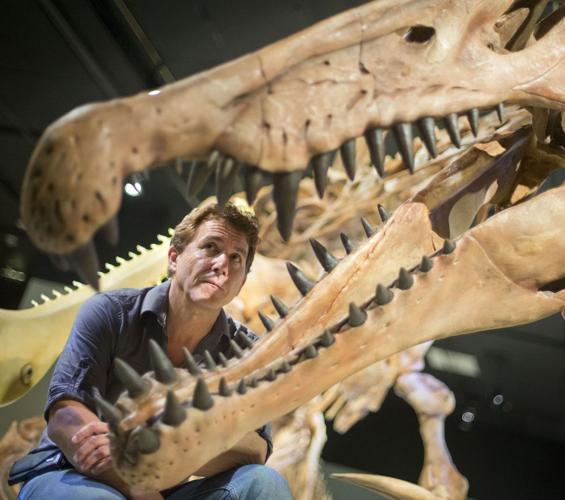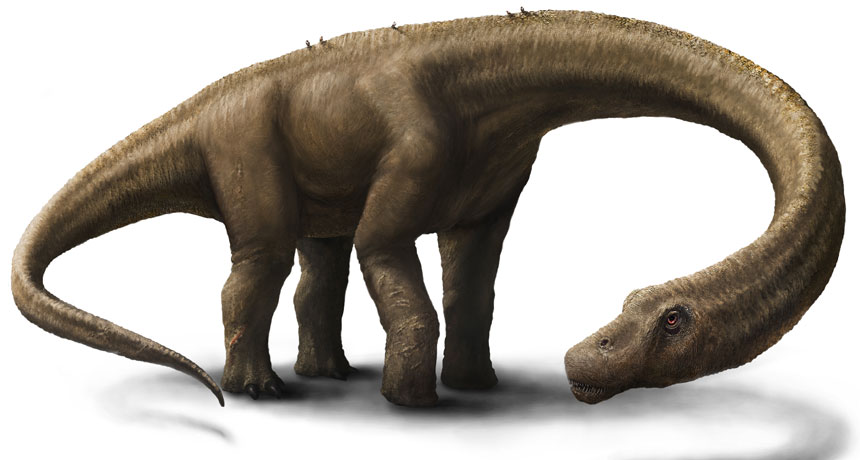Which Dinosaur Has 500 Teeth? Unveiling the Giant!
The dinosaur known for having 500 teeth is the Nigersaurus. This sauropod’s unique dentition has fascinated paleontologists since its discovery.
Discover the Nigersaurus, a Mesozoic era dinosaur that roamed the Earth approximately 110 million years ago during the Cretaceous period. Found in the Republic of Niger, this herbivore sported an astonishing array of teeth, totaling around 500, which sparked interest due to their sheer number and formation.
Its broad, straight-edged muzzle packed with rows of teeth was adept for grazing and is unlike any other known dinosaur. Nigersaurus has thus become a subject of intrigue and study among scientists, offering insights into the diverse adaptations of sauropods. Despite its long neck and massive body typical of sauropods, it’s the Nigersaurus’ teeth that remain the hallmark of its discovery, cementing its unique place in the paleontological records.
/https://tf-cmsv2-smithsonianmag-media.s3.amazonaws.com/filer/d3/c2/d3c266d9-7487-4082-b6de-17d6db732078/price_cldw_hogle_zoo_june_6_2012_015.jpg)
Credit: www.smithsonianmag.com

The Mystery Of The 500-toothed Dinosaur
Imagine a creature with 500 teeth! Such a dinosaur once roamed our Earth. The quest to know more about it fascinates scientists and dinosaur enthusiasts alike. This prehistoric puzzle isn’t just about the number of teeth but link to the daily life of this unique dinosaur.
Unearthing The Prehistoric Puzzle
Digging deep into the Earth’s layers, paleontologists came across an incredible discovery. A dinosaur known as Nigersaurus surfaced, boasting a jaw packed with hundreds of teeth. These teeth were not for biting like the fearsome T-Rex. They were for grazing on ancient forests.
- Nigersaurus was a sauropod, a long-necked dinosaur.
- It lived about 110 million years ago in what is now Africa.
- The dinosaur’s jaw held more than 500 teeth at once.
Why Teeth Count Matters
The number of teeth a dinosaur had can tell us about its diet and how it lived. Nigersaurus had teeth that were perfect for its lifestyle. Its 500 teeth were not all used at once. They wore down and got replaced.
- Teeth shape and count can indicate whether the dinosaur was a meat-eater, plant-eater, or both.
- Multiple sets of teeth mean that the dinosaur could replace them as they wore down.
- Frequent tooth replacement was key to its survival.
Each tooth was small and peg-like, ideal for feasting on soft vegetation. Alongside this, Nigersaurus likely had very weak bites. This is very different from the bone-crushing jaws of predators.
Remember, not all dinosaurs had such a high tooth count. This feature made Nigersaurus unique among its peers. It stands as a wonder of the dinosaur world.

Credit: www.santafenewmexican.com
Nigersaurus: The African Giant
Discover the Nigersaurus, a fascinating sauropod dinosaur with an astonishing 500 teeth, predominantly found in Africa’s lush habitats. This remarkable creature’s dental array uniquely adapted it for voracious plant-foraging, setting it apart in the prehistoric world.
Nigersaurus, a name that has intrigued paleontologists and dinosaur enthusiasts for years, became widely known for its unique dental structure. This prehistoric herbivore lived approximately 110 million years ago during the middle Cretaceous period. Famous for housing more than 500 teeth in its elongated skull, the Nigersaurus roamed the lush landscapes of what is now Africa.
Discovery And Excavation
Initial evidence of the Nigersaurus was discovered during the 20th century, but it remained an enigma until more substantial findings in the late 1990s. Notable paleontologist Paul Sereno led expeditions that unearthed pivotal fossils, piecing together the history of this African giant.
- Location: Gadoufaoua region, Republic of Niger
- Significant Year: 1997
- Expedition Team: Paul Sereno and his colleagues
Physical Characteristics Revealed
The relic bones of the Nigersaurus painted a detailed portrait of the dinosaur’s physical build. Its most striking feature: an extensive set of teeth specifically adapted for grazing ferns and other prehistoric plants.
| Nigersaurus Physical Traits | |
|---|---|
| Length: | Up to 30 feet |
| Weight: | Around 4 tons |
| Unique Dental Structure: | Over 500 slender teeth |
| Diet: | Herbivorous |
| Skull Shape: | Highly pneumatised and lightweight |
The teeth arrangement of the Nigersaurus is unparalleled, making it stand out as an epitome of evolutionary marvel. Rows of teeth lined up at the front edge of its mouth replaced worn chompers in a conveyor belt-like fashion. This distinctive mechanism allowed the dinosaur to maintain a perfect set for constant grazing.
Dental Anatomy Of A Marvel
Nigersaurus is the dinosaur with an impressive tooth count. Let’s explore the dental anatomy of this marvel. Its mouth was a formidable asset. This creature’s teeth tell us tales about its lifestyle. They turn pages back in time, to when dinosaurs roamed.
Unique Tooth Structure
The Nigersaurus is a record-breaker with up to 500 teeth in its arsenal. Its teeth had an unique design. We see a dental configuration that is hardly found in any other dinosaur. These teeth were not just plenty but also peculiar.
- Rapid Replacement: New teeth grew fast. This was a sign of heavy use.
- Organized Rows: Teeth were in 50 columns, with more on standby.
- Needle-like: Made for plucking, not for chewing hard objects.
Feeding Habits And Diet Insights
Understanding the diet of Nigersaurus is key. Its teeth shed light on what it ate. Here’s a snapshot of its likely menu:
| Food Type | Insights |
|---|---|
| Ferns | The teeth were perfect for soft greenery. |
| Horsetails | Easy to pluck for Nigersaurus’s fine teeth. |
| Angiosperms | Although rarer, these could have been part of the diet. |
The tooth shape and wear suggest a diet of ground-level plants. Its low-lying head, perfect for grazing, confirms this. With each bite, a few old teeth would be shed. New ones were always ready to take their place. This tells us the Nigersaurus was constantly eating soft plants.
Comparisons With Contemporary Dinosaurs
When you think of dinosaurs with an impressive tooth count, one dinosaur stands out. This dinosaur, known for having a staggering 500 teeth, prompts curiosity and comparisons with its ancient peers. Let’s delve into these comparisons to understand more about this creature and its counterparts from the same era.
Sauropod Relatives
The 500-teeth dinosaur belonged to a group known as sauropods. These were the giants of the dinosaur world. Known for their long necks and tails, sauropods roamed in herds eating plants all day. They needed many teeth to chew the tough prehistoric vegetation. Let’s see how it matched up with its relatives.
- Diplodocus: Long and slender with fewer teeth.
- Brachiosaurus: Taller, with bulkier bodies and not as many teeth.
- Apatosaurus: Robust build but fewer teeth than our 500-toothed friend.
Diversity Among Herbivorous Giants
In the time of the dinosaurs, size mattered, but so did tooth structure. The herbivorous giants, like our 500-toothed dinosaur, had to be well-equipped to process the foliage of their era. This dinosaur, along with its kin, showcases the incredible diversity that existed millions of years ago.
| Dinosaur | Teeth Count | Diet Type |
|---|---|---|
| Nigersaurus | 500+ | Herbivorous |
| Triceratops | Up to 800 | Herbivorous |
| Stegosaurus | Approximately 80 | Herbivorous |
Each of these dinosaurs had a unique way of surviving. Some had sharp teeth for slicing plants. Others, like our 500-toothed dinosaur, processed food with many small, leaf-shaped teeth. This varied approach highlights their survival strategies in a competitive world.
Nigersaurus In Popular Culture
The Nigersaurus, a dinosaur famous for its 500 teeth, has walked out of ancient history into modern culture. This long-necked, plant-eating dinosaur sparks curiosity among dinosaur enthusiasts across the world.
Internet Fame And Misinformation
The Nigersaurus made waves on the internet for its unique dentition. A meme suggested searching for ‘dinosaur with 500 teeth’ would lead to an unexpected result. People were intrigued and the search term saw a surge in popularity. However, this also led to the spread of inaccurate information and jokes, some of which distorted the dinosaur’s true nature.
- Surge in popularity due to an internet meme
- Inaccurate information and jokes spread
- True nature of the dinosaur often misrepresented
Educational Impact
Despite the internet’s role in spreading misinformation, the Nigersaurus has also had a significant impact on education. Its discovery enlightens students about the diversity in the ancient world. Teachers and educational platforms capitalize on the dinosaur’s popularity. They use its intriguing characteristics to spark interest in paleontology and science among young minds.
| Benefit | Example |
|---|---|
| Enhances learning | Information on Nigersaurus included in science curricula |
| Encourages curiosity | Interactive exhibits in museums |
| Stimulates interest in paleontology | School projects and documentaries |

Credit: www.snexplores.org
Conclusion
Exploring the prehistoric realm of dinosaurs is always a fascinating journey. The Nigersaurus, with its impressive 500 teeth, stands out among these ancient beasts. Remember to share this article about such a unique creature, and stay curious as you uncover more dinosaur facts.
Keep adventuring into the past!




